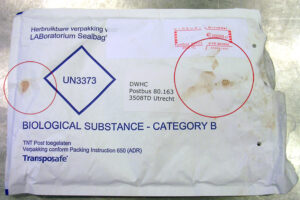2009 – 2010: National surveillance of infection and disease in deer with epizootic hemorrhagic disease virus infection (pilot)
The Project

Photo: Ton Richter
Deer (Capreolus capreolus) are ruminants, several species of which occur in large numbers (> 60,000) throughout the Netherlands. National surveillance and early warning of infection and disease in deer can inform policies regarding these diseases in domestic animals and humans. The representative sampling of the Dutch deer population requires the participation of volunteers and employees of various wildlife management and research organisations (e.g. Dutch Wildlife Health Centre (DWHC) and the Central Veterinary Institute of Wageningen UR (CVI)). This pilot study will be conducted to ascertain the prevalence of epizootic hemorrhagic disease virus (EHDV) infection in wild deer in the Netherlands.
EHDV is a viral disease of ruminants transmitted by biting insects. In the past it has been responsible for mass die-offs amongst white-tailed deer (Odocoileus virginianus) in North America and infection in farmed deer has also been reported. It has recently been shown that this virus was the cause of clinical signs and production losses in cattle during outbreaks in Turkey, Israel and North Africa. EHDV is genetically very similar to blue tongue virus and African horse sickness which are also transmitted by biting flies (Culicoides spp.). This new finding, representing an increased risk to European livestock and thereby the potential to cause economic losses, means that EHDV has been classified as a Notifiable disease since 2008.
This project consists of four activities:
- Creation of a national sampling network
- Determination of virus prevalence in wild deer in the Netherlands
- Collection of sera from wild deer to ascertain previous infection/exposure to EHDV amongst wild deer
- Sharing of information amongst field workers to increase familiarity with the disease and therefore to increase the chance of early warning from the field
The project was launched at the end of November 2009 and is being funded by the Dutch Ministry for Agriculture, Nature and Food Quality (LNV).
Progress reports
December 2009:
- Fauna management and hunters organisations requested the cooperation of wildlife management organisations.
- Wildlife management organisations received information and sampling material.
- The first blood samples were submitted from the field.
June 2010:
- During the culling season 364 samples (from does and fawns) were submitted. The number of samples varied amongst the different submitting organisations, for example some only sampled euthanised diseased animals.
- At the end of April 2010 the plan to sample 200 stags was rolled out.
- Doe and fawn samples were sent to the CVI for EHDV testing.
The results
Provisional results (in Dutch) are available here.
Tips…
To improve the quality of blood samples:
- Samples should be taken as soon as possible after the animal has been euthanised, preferably from inguinal or axillary blood vessels or the heart or great vessels.
- The blood tubes with the pink-red top (EDTA-tubes) should be gently rotated 10 times to distribute the EDTA fluid through the sample.
- Samples should be submitted as soon as possible after being taken.
For hygienic submissions:
Ensure that the envelope/ packaging is not soiled (full sampling instructions are available in Dutch here)




